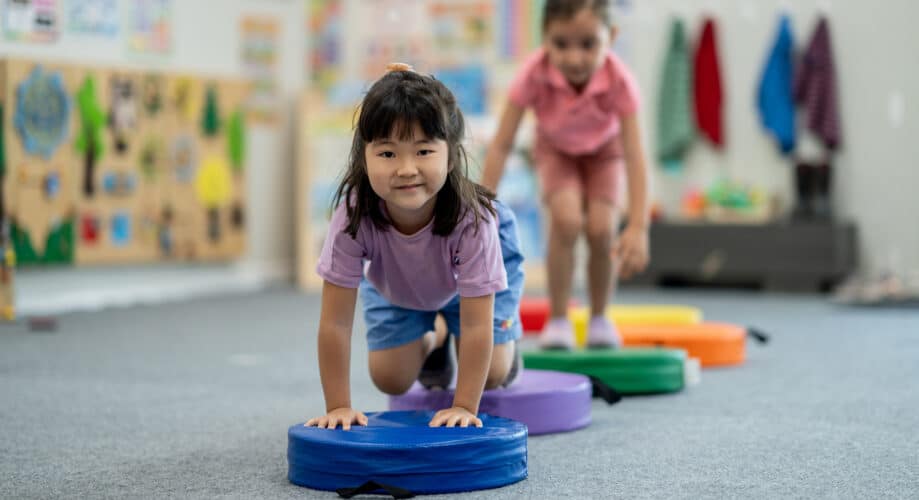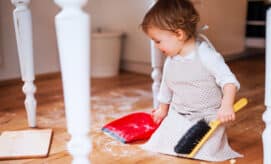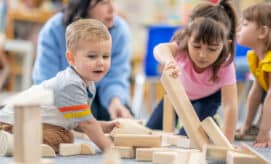During their preschool years, children learn, grow, and gain new skills every day. Educators who care for children at this stage play an important role by creating play-based learning experiences that support skill development across a variety of domains—from cognitive and physical development to language and social-emotional learning. In this article, we offer preschool educators tips for planning a well-rounded curriculum with a range of engaging experiences that will support the key components of preschooler learning and skill development.
Build Cognitive Skills with Creative & Imaginative Play
Imaginative and creative play encourages children to think flexibly, problem-solve, and explore new ideas. Art, music, and pretend play offer children the opportunity to express their ideas as they build critical skills in executive functioning, attention and focus, perspective-taking, and more. An article from Michigan State University explains, “Art can help children learn and practice skills like patterning and cause and effect…They can also practice critical thinking skills by making a mental plan or picture of what they intend to create and following through on their plan.”
Below are examples of the types of creative and imaginative play activities that support children’s cognitive development, as well as links to specific ideas to try in each category.
- Set up process art projects that invite children’s natural inclination to use their imagination and think creatively.
- Create spaces for imagination by setting up an area in your classroom that is dedicated to dramatic/pretend play.
- Integrate music and movement into daily activities to support mindfulness and peer collaboration.
- Incorporate wordless picture books into your classroom’s story time to encourage children to use their imagination and creativity to create a story based on the images.
Build Motor Skills through Active Play
Preschoolers are on the move! As their coordination, strength, and confidence continue to develop, they are drawn to active games and activities. An article from the pediatric practice, CommonWealth Pediatrics, notes, “Active play, which includes running, jumping, climbing, and other forms of physical activity, helps children develop strong muscles and bones. It enhances motor skills, both gross and fine, and improves coordination and balance. Activities like playing tag, riding bikes, or participating in sports are all excellent ways for children to build their physical strength and endurance.”
Educators can support children’s development by setting up opportunities for active play throughout the day, such as:
Build Self-Confidence with Opportunities for Independence
Preschoolers enjoy opportunities to take on responsibility and demonstrate independence. In a preschool classroom, this might look like taking on a role during daily routines and activities, or being invited to help with classroom maintenance tasks. These simple activities support developing leadership skills, self-confidence, independence, and autonomy, while also encouraging a sense of shared community in your early learning space.
- Invite children to make small choices throughout the day, by asking questions like, “Should we use crayons or markers for our art project today?”
- Encourage children to take part in creating some simple rules for your classroom.
- Create opportunities for children to do simple jobs around the classroom, such as wiping down tables after snack time, sweeping the floor at the end of the day, or putting away bedding after naptime, to help maintain the environment.
Build SEL Skills through Conversations about Feelings
Preschoolers are still developing the skills to manage and express their big feelings. Educators can support their emotional development by helping them to recognize, understand, and express their internal experience.
An article from Penn State’s early childhood program explains, “The process of calming down when upset and using words to describe feelings and address challenges requires a lot of practice…Helping children to identify and label emotions is an important first step…Adults support children’s social-emotional development when they label and talk about emotions.”
We can facilitate these conversations with some simple strategies.
- Reading books about feelings with young children and talking with them about their own experiences can help children become more aware of their emotions.
- When we see a child displaying a certain emotion, we might verbalize our observations with them to help build their feelings vocabulary. For example, we might say, “I see you stomping your feet, which tells me you’re feeling angry right now,” or “Mom’s here to take you home! I can see how excited you are to see her!”
Build Communication & Language Skills through Social Interactions
During the preschool years, children’s developing social-emotional skills encourage them to seek out opportunities to play and engage with their peers. Group play becomes more meaningful and collaborative, and children learn how to navigate friendships. As they engage with others, little ones develop their ability to empathize and to use communication skills in situations requiring negotiation, conflict resolution, and problem-solving.
Educators can support children’s developing social and communication skills by offering group activities that encourage meaningful social interactions, such as:
- Setting up a group story time in which all children can participate and reflect upon the story after hearing it.
- Offering collaborative art projects that children can work on together, each enjoying their unique role in the process.
- Organizing outdoor activities that give children the option of working independently or with peers, such as drawing with chalk, playing in the sand, hopscotch, obstacle courses, and more.
Build STEM Skills through Open-Ended Play
Young children explore science, technology, engineering, and math (STEM) concepts through open-ended play. Open-ended play refers to activities and experiences in which children can freely explore, create, and experiment, using their imagination to guide the experience. In open-ended play, there is no intended outcome or goal, and the focus is on investigation and fun! In a preschool classroom, open-ended activities might include building with legos, playing in a water sensory bin, or using magnifying glasses to explore the environment. All of these develop important STEM skills, such as problem-solving, cause and effect, experimentation, measurement, comparison, and more!
Early childhood educators can incorporate STEM-rich open-ended play by…
- offering children loose parts to explore, and regularly rotating materials to encourage fresh experiences
- encouraging trial-and-error thinking by asking open-ended questions such as, “What do you think will happen if…?” or “Can you think of any ways that you could make your structure stronger?”
- spending time in nature to enjoy all of the STEM learning experiences that the outdoors has to offer, such as observing wildlife, building with sticks and other natural items, or collecting and investigating different kinds of leaves.





